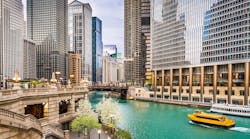About the author: Chris Kloss is senior environmental scientist for Low Impact Development Center Inc. Kloss can be reached by e-mail at [email protected]. Photos provided by Martina Frey.
Identified by the U.S. Environmental Protection Agency (EPA) as one of the primary causes of water impairment, storm water continues to present management problems to cities across the country and pollute a significant percentage of urban waters. Urban waters should be an amenity for the cities that surround them, but they often end up as a destination for trash and a variety of other pollutants, contributing to a reduced quality of life for residents.
U.S. Geological Survey studies of urban streams find that concentrations of total phosphorus exceed EPA goals for nuisance growth in 70 percent of streams; insecticides are usually at a higher concentration than in agricultural areas; and fecal coliform bacteria commonly go beyond recommended standards for water recreation. Additionally, combined sewer systems in nearly 750 municipalities deliver 850 billion gal of untreated overflows to urban waters each year.
Bioretention plants treat street and sidewalk runoff.
Limiting storm water pollution will require significant capital investment to enhance the performance of an aged and often inadequate wastewater infrastructure that largely predates modern water treatment practices. The EPA’s latest Clean Watersheds Needs Survey estimated that more than $10 billion and $60 billion is needed for storm water management and combined sewer overflow (CSO) correction, respectively.
As cities look to become more sustainable, these needed capital improvements, while daunting, present an opportunity to re-evaluate the most efficient way to invest in infrastructure and environmental programs. Traditional improvements to storm water and wastewater infrastructure have focused on capacity and conveyance and have literally buried the investments out of sight.
A Viable Option
To make more of limited municipal dollars, several cities have begun using "green" infrastructure to manage storm water, enhance their infrastructure and provide an array of environmental benefits. Green infrastructure introduces trees and vegetation, or engineered systems that mimic natural processes, into the urban environment to manage storm water in a more comprehensive fashion. Using soil and vegetation as components of the infrastructure system allows rain to infiltrate, evapotranspirate or be otherwise retained, capturing and treating rain where it falls and managing storm water before it enters the collection system.
The EPA has endorsed green infrastructure as a viable option for storm water and CSO control. The agency and the cities that use green infrastructure recognize that it can complement gray infrastructure by limiting the demand placed on the collection and treatment system, enhancing capacity and improving performance.
Chicago, Portland and Seattle have been at the forefront of the green infrastructure movement. These cities have creatively and effectively used green roofs, bioretention, permeable pavements, storm water reuse and other practices to significantly reduce runoff volumes, limiting inflows into combined sewer systems and discharges to receiving streams.
Downspouts directed to vegetated planter boxes at Portland State University.
Portland’s residential downspout disconnection program alone diverts nearly 1.5 billion gal of storm water from the combined sewer system annually by allowing the rain to soak into the ground. The $8 million investment in the subsidized program has saved the city $250 million in infrastructure improvements. Monitoring of Seattle’s natural drainage systems has shown that the pilot projects have retained 75 to 99 percent of rainfall and prevented it from being discharged to sensitive receiving waters where salmon live.
Added Environmental Benefits
While the storm water benefits are significant, green infrastructure offers other environmental improvements as well. By substituting soil and vegetation for hard, heat-absorbing materials common in urban areas, creating shade and emitting water vapor, green infrastructure effectively counteracts urban heat island.
Temperatures above Chicago’s City Hall green roof average 10°F to 15°F lower than a nearby black tar roof, and the difference is as much as 50°F in August. Green roofs and other vegetation incorporated on and around buildings help shade and insulate them from wide temperature swings, decreasing the energy needed for heating and cooling. Estimates suggest that green roofs can reduce the heating and cooling costs of a building by 10 to 15 percent; in the case of Chicago’s City Hall, energy savings have amounted to about $3,600 annually.
Green infrastructure also improves air quality, since vegetation absorbs gaseous air pollutants and adsorbs particulates. And the aesthetic and social benefits of greener cities cannot be overlooked either. Research indicates that property values increase when street trees are planted and vacant lots are greened, providing private benefits to homeowners, increased property tax revenue and more livable communities.
Efficiently and effectively managing both natural and economic resources is critical to creating sustainable cities. By utilizing the free benefits of nature and capturing the asset value of ecosystem services, green infrastructure is able to maximize economic investments, provide multiple environmental benefits and create an efficient approach to integrated urban management.

